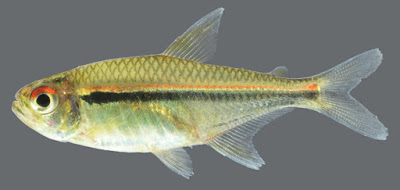ABSTRACT
A new species of Hyphessobrycon belonging to the Hyphessobrycon heterorhabdus species-group from the lower rio Tapajós, state of Pará, Brazil, is described. The new species is allocated into the Hyphessobrycon heterorhabdus species-group due to its color pattern, composed by an anteriorly well-defined, horizontally elongated humeral blotch that becomes diffuse and blurred posteriorly, where it overlaps with a conspicuous midlateral dark stripe that becomes blurred towards the caudal peduncle and the presence, in living specimens, of a tricolored longitudinal pattern composed by a dorsal red or reddish longitudinal stripe, a middle iridescent, golden or silvery longitudinal stripe, and a more ventrally-lying longitudinal dark pattern composed by the humeral blotch and dark midlateral stripe. It can be distinguished from all other species of the group by possessing humeral blotch with a straight or slightly rounded ventral profile, lacking a ventral expansion present in all other species of the group. The new species is also distinguished from Hyphessobrycon heterorhabdus by a 9.6% genetic distance in the cytochrome c oxidase I gene. The little morphological distinction of the new species when compared with its most similar congener, H. heterorhabdus, indicates that the new species is one of the first truly cryptic fish species described from the Amazon basin.
Keywords: Biodiversity; Cryptic Species; DNA Barcoding; Rio Amazonas; Rio Tapajós.
 |
| Hyphessobrycon cantoi. Living specimen, Brazil, Pará, Santarém, stream tributary of lago Maicá (not preserved). |
Hyphessobrycon cantoi, new species
Diagnosis. Hyphessobrycon cantoi can be distinguished from all congeners, except H. amapaensis, H. ericae, H. heterorhabdus, H. sateremawe and H. wosiackii, by the presence of an elongated, anteriorly well-defined humeral blotch that becomes progressively diffuse and blurred posteriorly, overlapping with a midlateral dark stripe. Hyphessobrycon cantoi can be distinguished from H. ericae and H. wosiackii by lacking a caudal peduncle blotch (vs. presence of a caudal peduncle blotch). Hyphessobrycon cantoi can be distinguished from H. amapaensis, H. heterorhabdus and H. sateremawe by lacking a ventral extension of the humeral blotch (vs. ventral extension of the humeral blotch present, although absence of ventral extension may occurs in specimens of H. amapaensis). Hyphessobrycon cantoi can be further distinguished from H. amapaensis by presenting a conspicuous midlateral dark stripe (vs. inconspicuous midlateral dark stripe) and by possessing a relatively thin red longitudinal stripe (vs. midlateral red stripe very thick and conspicuous). Hyphessobrycon cantoi can be also further distinguished from H. sateremawe by presenting a humeral blotch narrower, occupying vertical height equivalent to less than one scale row to middle of body (vs. humeral blotch and continuous midlateral stripe broad, occupying vertical height equivalent of two scale rows to middle of body). Hyphessobrycon cantoi is also distinguished from H. heterorhabdus by >9% of genetic distance in the cytochrome c oxidase I (COI) gene. Hyphessobrycon cantoi can be distinguished from H. heterorhabdus by 53-79 mutations and from H. ericae by 87 mutations in the COI gene (S3).
Etymology. The specific name is a homage to André Luiz C. Canto, curator of the fish collection of the Universidade Federal do Oeste do Pará (UFOPA), in recognition of his contribution to the knowledge of the fishes from the rio Tapajós basin. A genitive noun.
Tiago C. Faria, Karen L. A. Guimarães, Luís R. R. Rodrigues, Claudio Oliveira and Flávio C.T. Lima. 2021. A New Hyphessobrycon (Characiformes: Characidae) of the Hyphessobrycon heterorhabdus species-group from the lower Amazon Basin, Brazil. Neotrop. ichthyol. 19(1); DOI: 10.1590/1982-0224-2020-0102
